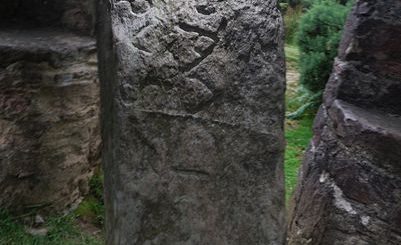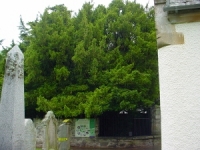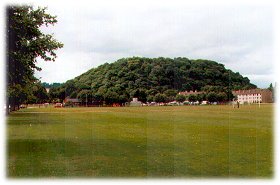Crossraguel Abbey
The ruins of this relatively little known abbey are remarkably intact, and stand in a part of Ayrshire steeped in history. As well as being historically interesting there are many enigmas associated with the abbey, which could well be worth further research. There may have been a Pictish site here, and some people suggest that the abbey may have a Templar connection.
 History
History
The abbey was founded by Duncan the Earl of Carrick around 1244, after he donated money to the monks of Paisley to build an abbey on the spot. After some legal wrangling the abbey was completed and monks from Paisley were sent to run it, after which it became independent in its own right. The name of the abbey is possibly related to an ancient cross which stood on the spot, and it may mean abbey of the royal (regal) cross, or the abbey of the cross of Riaghail, perhaps an ancient king, in truth nobody is certain. Crossraguel was a Clunaic abbey, which was a branch of the Benedictines, and the monks were known as the ‘Black Monks’ from the colour of their habits.
 The abbey saw its share of turmoil, in 1307 an invading army led by Henry Percy under Edward I sacked the abbey. The defeat of his forces may have led to the destruction in a bid for revenge before returning home. In any event the abbey was rebuilt in a much more grandiose scale and lasted until after the reformation in the hands on the charismatic abbot Quintin Kennedy, who died in 1564. His influence in the area is probably down to his bloodline with the powerful Earl of Cassilliss. Even after his death a few monks were said to have stayed in the half ruined buildings, in spite of great secular changes in favour of the Protestant creed. As with many ancient abbeys it was plundered for building stone after its ruination, mainly to build some of the local housing, but it is still remarkably intact.
The abbey saw its share of turmoil, in 1307 an invading army led by Henry Percy under Edward I sacked the abbey. The defeat of his forces may have led to the destruction in a bid for revenge before returning home. In any event the abbey was rebuilt in a much more grandiose scale and lasted until after the reformation in the hands on the charismatic abbot Quintin Kennedy, who died in 1564. His influence in the area is probably down to his bloodline with the powerful Earl of Cassilliss. Even after his death a few monks were said to have stayed in the half ruined buildings, in spite of great secular changes in favour of the Protestant creed. As with many ancient abbeys it was plundered for building stone after its ruination, mainly to build some of the local housing, but it is still remarkably intact.
The chapter house is one of the best-preserved parts of the buildings, and is particularly acoustically resonant, although my tone-deaf gregorian chanting didn’t endear me to my companions.
 The Enigmas
The Enigmas
The abbey is atmospheric to say the least, perhaps in part because of its mixture of complete buildings vying with gaunt ruins, so that one minute you can be walking through a part of the abbey as the monks would have seen it, and the next forward in time to the shell of the church, open to the elements. It is easy to visualise the monks in their every day activities.
 You can get carried away with the romance of the place but there are other clues within the abbey to perhaps greater mysteries. One is the stone which is set into the lower wall of the abbey, anybody who is familiar with the Burghead Pictish bull carving will see the similarities in shape straight away, and the stone may date back much further than the abbey.
You can get carried away with the romance of the place but there are other clues within the abbey to perhaps greater mysteries. One is the stone which is set into the lower wall of the abbey, anybody who is familiar with the Burghead Pictish bull carving will see the similarities in shape straight away, and the stone may date back much further than the abbey.
Just what it is doing in the abbey wall is anybody’s guess but it is definitely hand carved, and not in a place where it was put for show. It may be pictish – who knows – if it is it suggests a Pictish stronghold much further West than is usual, and it would be interesting to know if anybody has any ideas about its origin. Perhaps – to speculate more wildly – this is part of the carving from the ancient cross from which the abbey took its name.
 The abbey – particularly the chapter house – is full of mason’s marks, although these are not unusual in themselves (they were used to identify which stonemason should be paid for what work) some have been traced back to that enigmatic tapestry in stone Rosslyn Chapel (this may be coincidence). This has led some people to conclude that the Templars were involved with the abbey in some way, another clue being the beehive dovecot, although this dates to the 16th century.
The abbey – particularly the chapter house – is full of mason’s marks, although these are not unusual in themselves (they were used to identify which stonemason should be paid for what work) some have been traced back to that enigmatic tapestry in stone Rosslyn Chapel (this may be coincidence). This has led some people to conclude that the Templars were involved with the abbey in some way, another clue being the beehive dovecot, although this dates to the 16th century.
 Another ‘unknown’ relates to the meaning of the hearts carved on to the cross, which surmounts the remains of the church. It has been speculated that this is related to Robert the Bruce in some way, as he was known as Braveheart (not Wallace incidentally) and it may relate to his hearts posthumous journey to the East, where it led his followers into battle for the last time, but then such tenuous ties are open to debate and may be the grounds for further research, who knows what might turn up?
Another ‘unknown’ relates to the meaning of the hearts carved on to the cross, which surmounts the remains of the church. It has been speculated that this is related to Robert the Bruce in some way, as he was known as Braveheart (not Wallace incidentally) and it may relate to his hearts posthumous journey to the East, where it led his followers into battle for the last time, but then such tenuous ties are open to debate and may be the grounds for further research, who knows what might turn up?
The abbey also has a green man, and a carving of a mermaid a rare find in a Scottish abbey.
Directions: The abbey is situated next to the A77 about 2 miles South of Maybole.




Recent Comments